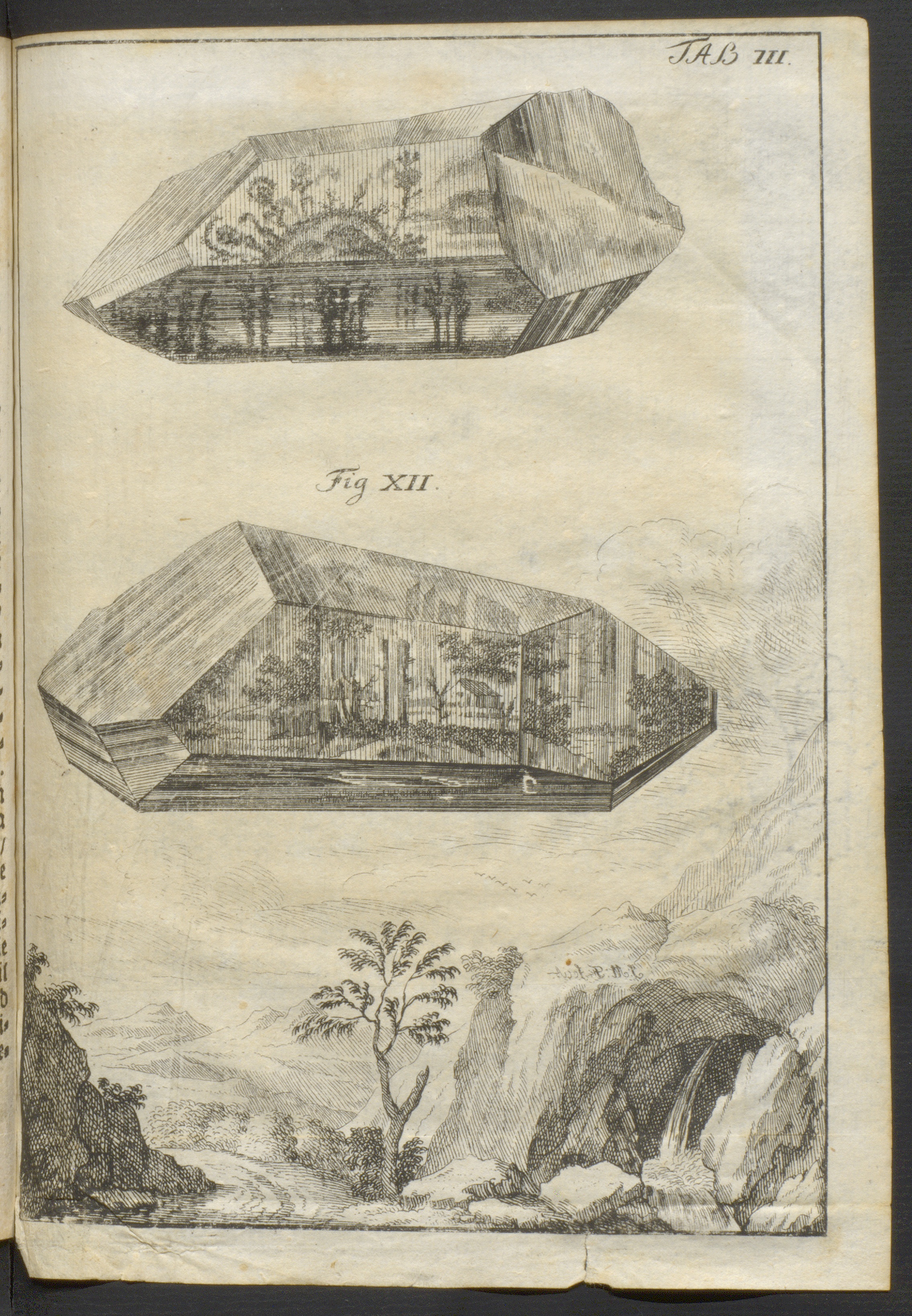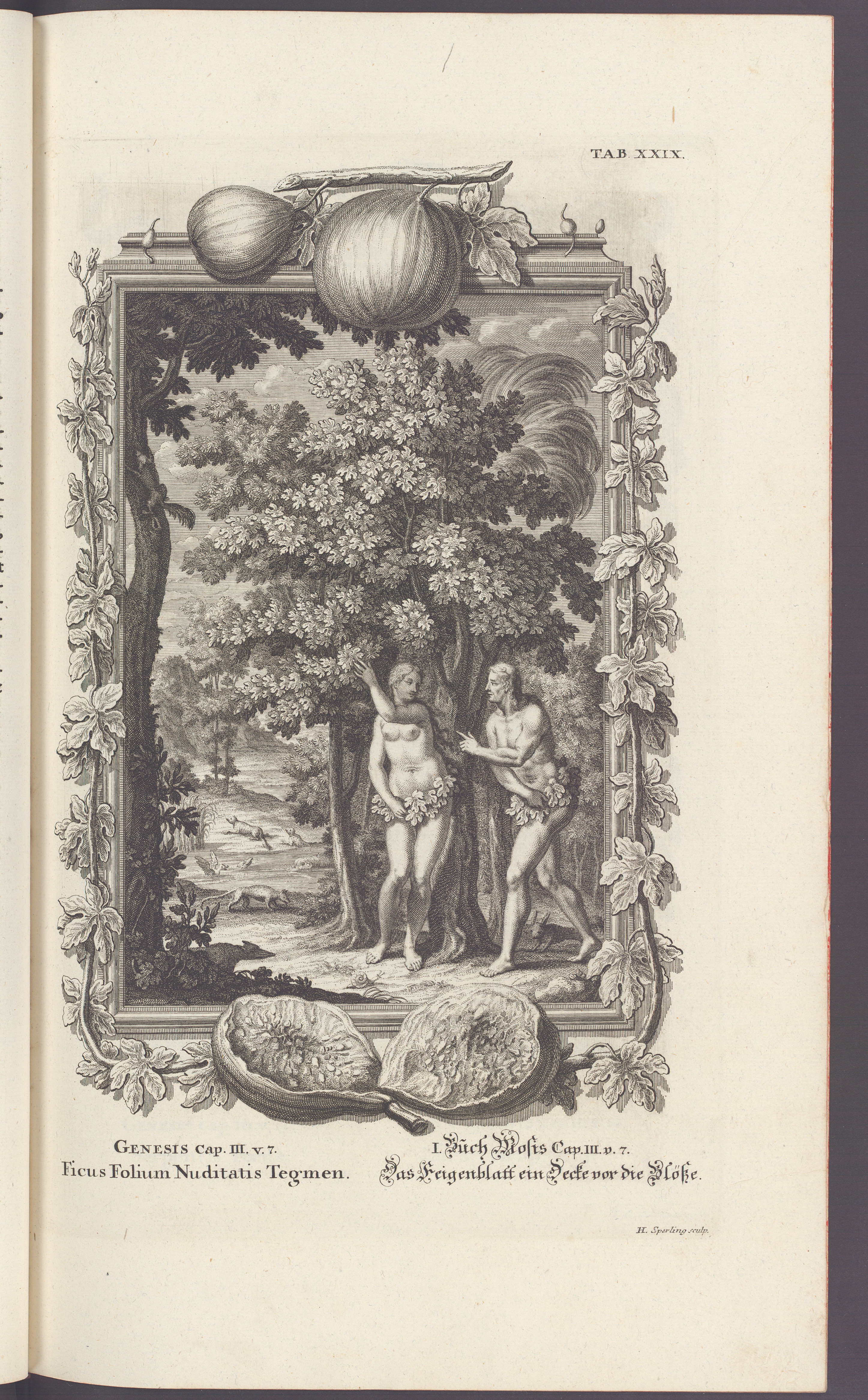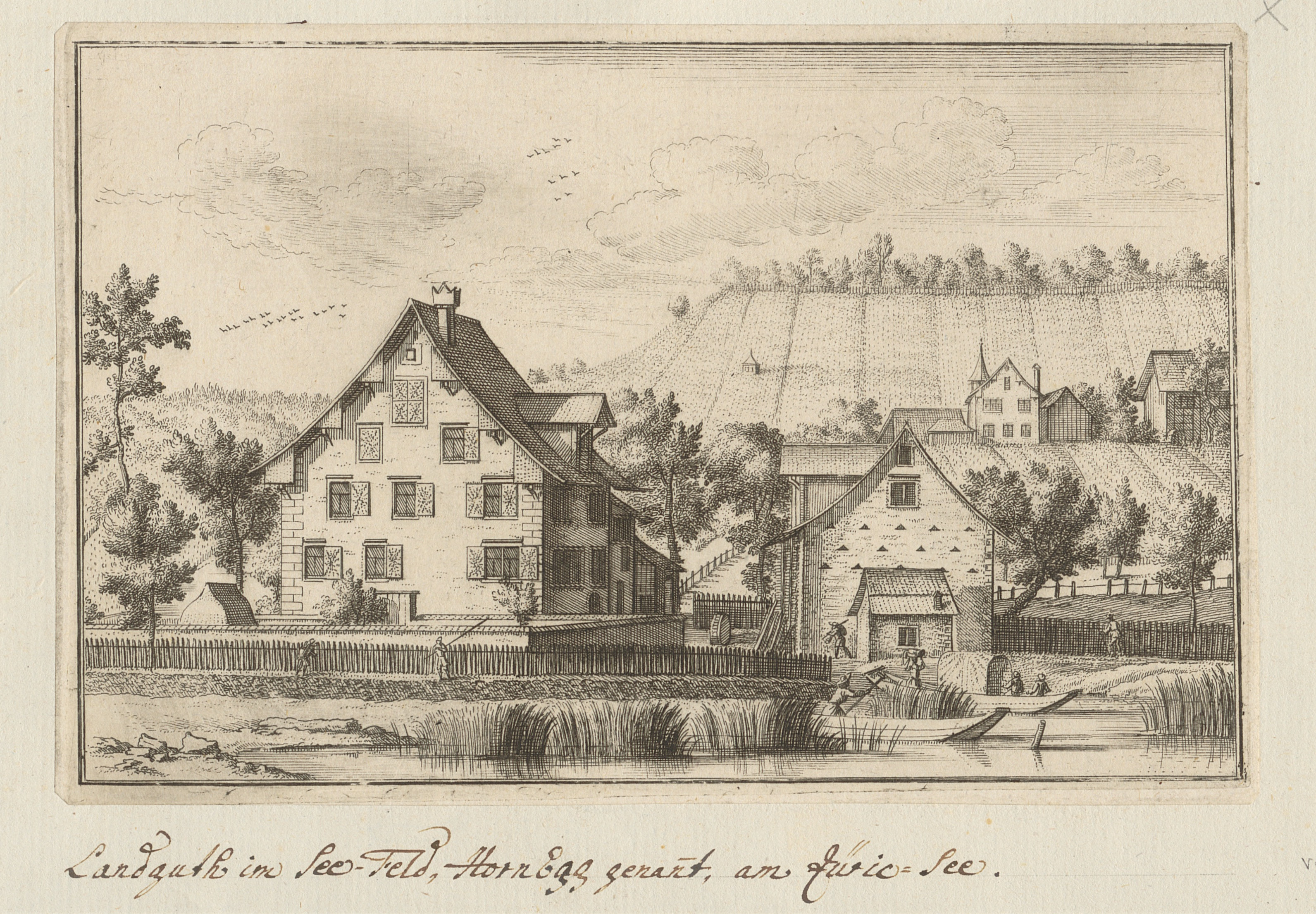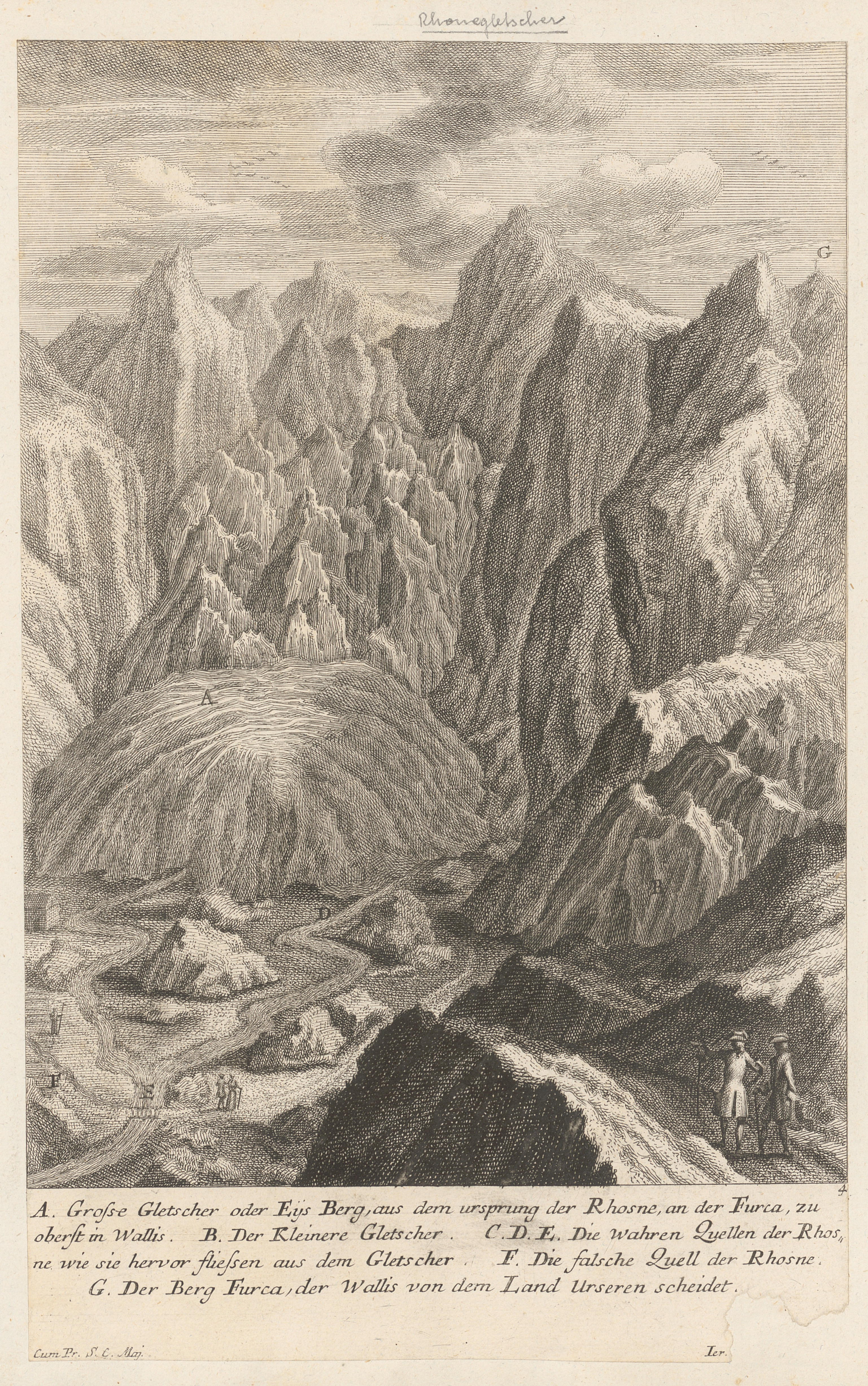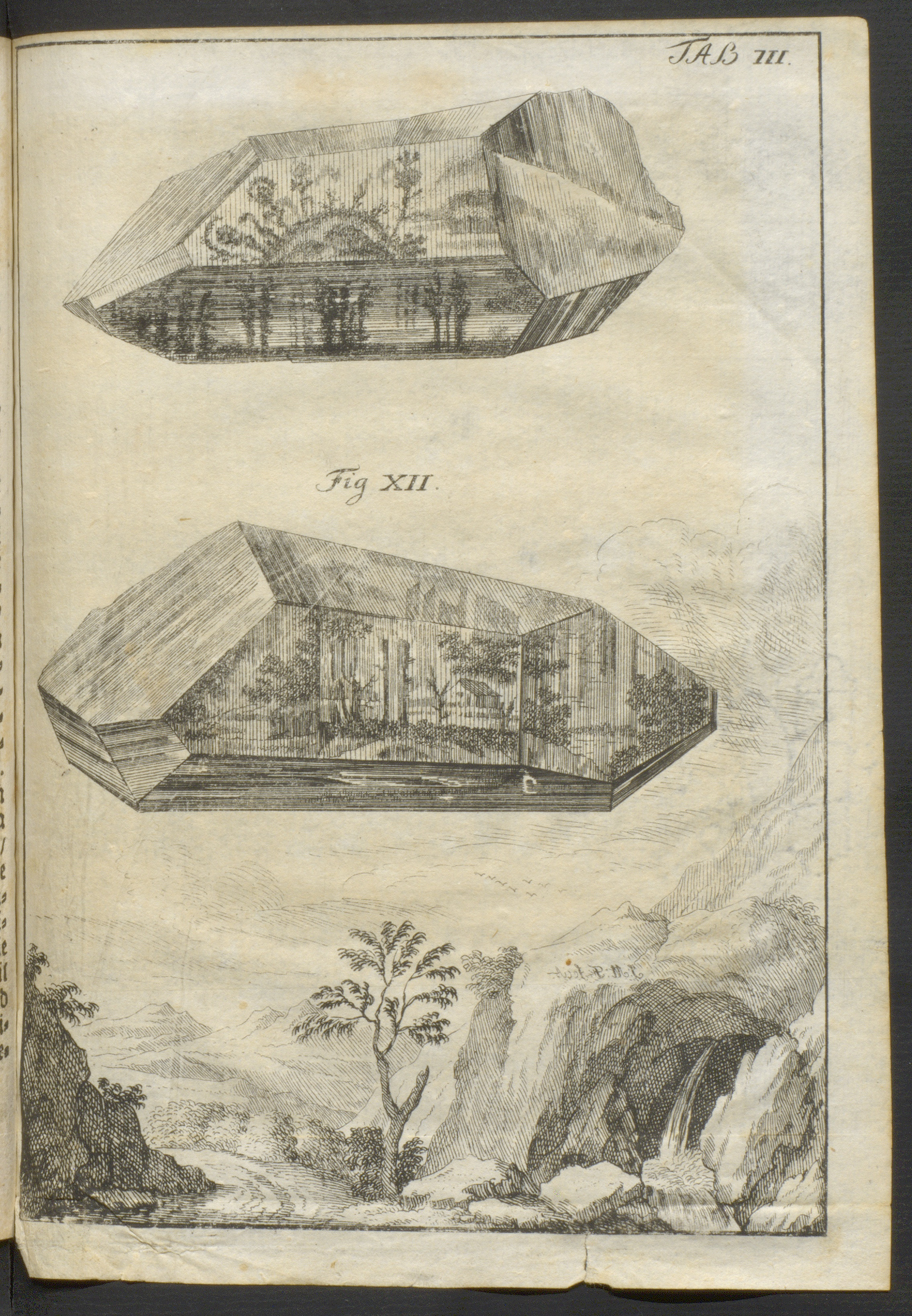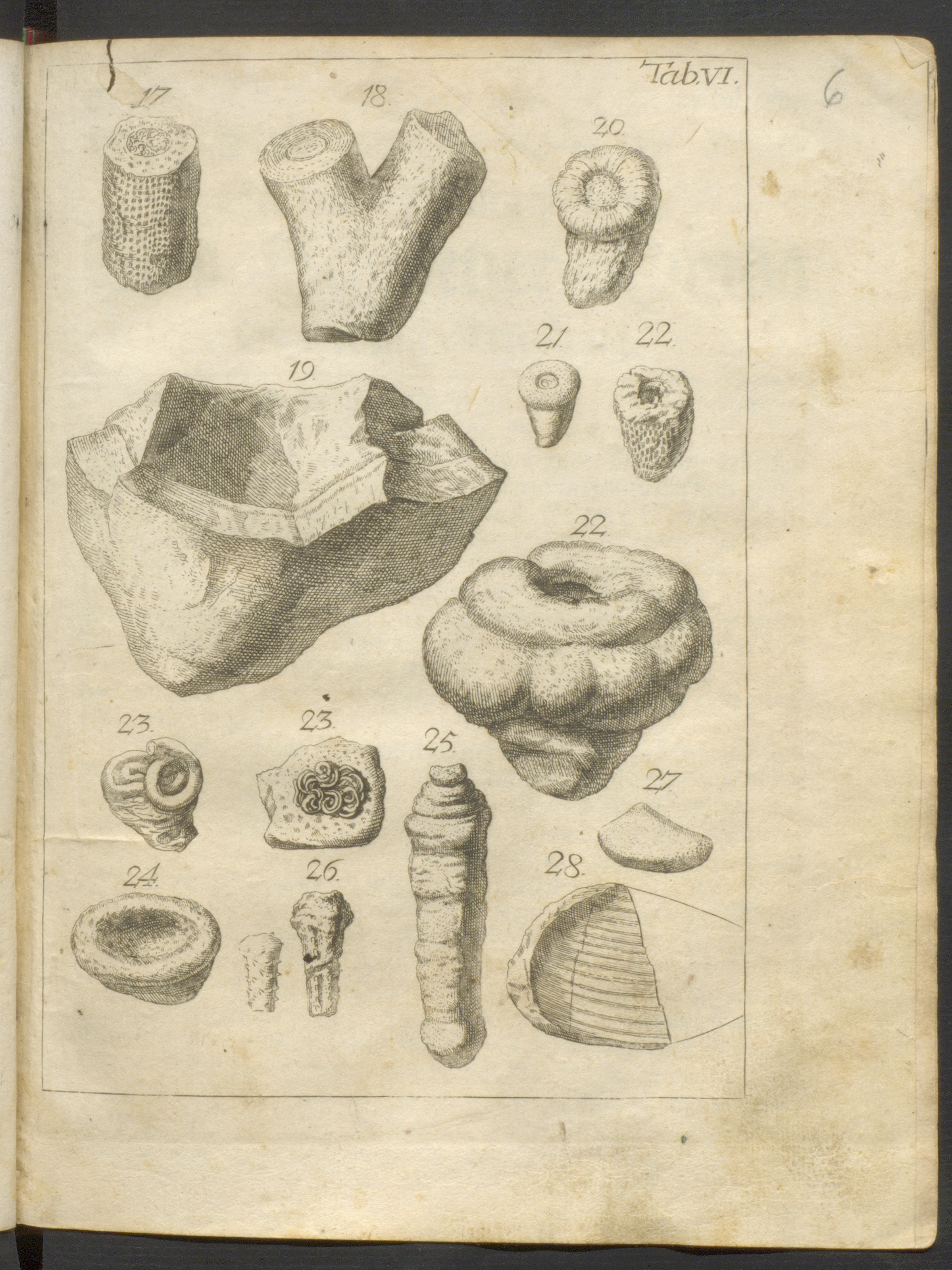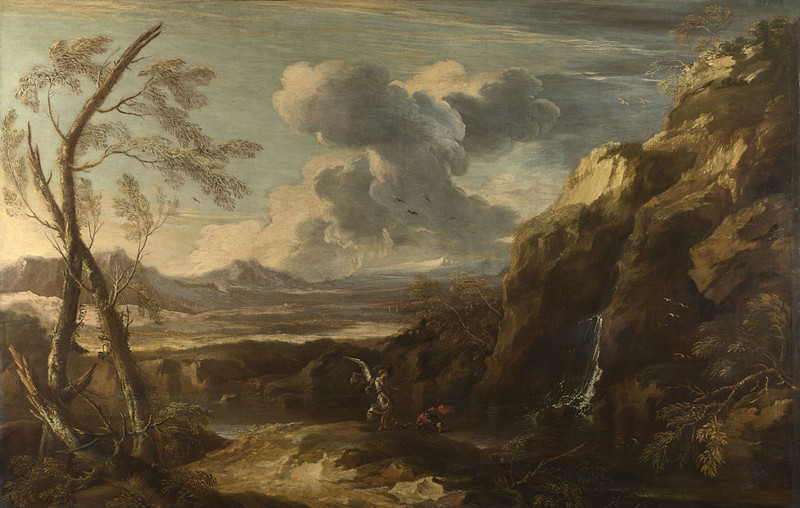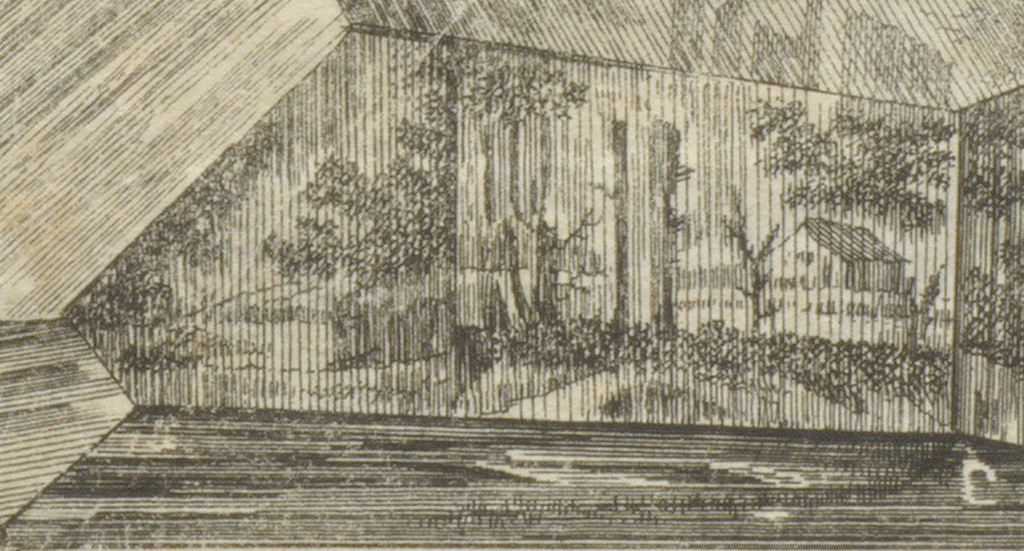At the very beginning of the 18th century, the Swiss scholar Johann Jakob Scheuchzer engaged himself in a reflection about the generative capacity of nature and the importance of visual perception in the discovery of these natural processes. These ideas came to the fore when he studied a very specific type of crystal, the dendrite, that bears arborescent forms on its surface. The aim of this essay is to wind up the thread of Scheuchzer's thought by revealing, through a reading of the many metaphors used, his theory about the generation of crystals and the role of this theory within the physico-theological discursive apparatus of the naturalist.
C'est que la forme est enveloppée d'un halo. Elle est stricte définition de l'espace, mais elle est suggestion d'autres formes. Elle se continue, elle se propage dans l'imaginaire, ou plutôt nous la considérons comme une sorte de fissure, par laquelle nous pouvons faire entrer dans un règne incertain, qui n'est ni l'étendu ni le pensé, une foule d'images qui aspirent à naître.
Henri Focillon1
Focillon offers us here a definition of form as a shared territory for the expression of perception and imagination2 to which the Zurich-based naturalist3 Johann Jakob Scheuchzer (1672-1733) would certainly have been receptive, given that his scientific treatises and the engravings that accompany them are marked by the question of perception4. At the very beginning of the 18th century, this scholar — an active member of the Republic of Letters5 — was himself engaged in a reflection on the generative capacity of nature and the importance of visual perception in the discovery of these natural processes. These ideas came to the fore when he studied a very specific type of crystal. Through a reading of the metaphors he used along one particular treatise, we can wind up the thread of Scheuchzer thoughts by discovering his theory about the generation of crystals and the role of this theory within the discursive apparatus of the Swiss naturalist. Made by the Zurich-born artist Johann Melchior Füssli (1677-1736), an engraving accompanies the treatise. This essay proposes a close reading of this engraving alongside Scheuchzer’s scientific treatise. By deconstructing the composition of the image, we will discover that each element, in particular the landscape and the architectural structure, are carefully selected and formally designed for their ability to ingeniously — through the sheer force of artistic creation — send the viewer back to the renewal of a world that was once destroyed.
This can only be done through a close reading of Scheuchzer's treatise, but also with the help of an analysis of the image that accompanies it. Both are included in the 19th volume of the Beschreibung der Natur-Geschichten des Schweizerlands. This encyclopaedic work — published exclusively in German between 1706 and 1708 — promotes a form of popularisation of the natural sciences6 while at the same time satisfying a Swiss patriotic ambition7. Likewise, the Christian faith found a gracious place in it, in line with the logic of the physico-theological thinking of which Scheuchzer was an eminent representative8. This school of thought, which was widespread from the end of the seventeenth century, mainly in Protestant areas9, saw living things as evidence of a divine plan, and thus enabled the discoveries of naturalists and the history of the Bible to resonate with each other10. Scheuchzer, therefore turns to Scripture when reporting on new knowledge about natural processes. This was particularly true for the flood, to which almost all his research refers and to which he dedicated a treatise in 1716, the Museum diluvianum. Placing God at the origin of nature and its movements had become necessary to counter the gradual questioning of his role regarding the ever-increasing scientific advances11. Physico-theology therefore proposes to understand the language of the Bible as so many useful metaphors to counter the contradictions between Scripture and empirical discoveries12. In Scheuchzer's work, we shall see that, metaphors are omnipresent both in the texts and in the images that accompany them.
The best-known, most studied and most representative example of Scheuchzer's physico-theological thinking is the last of his works, the Physica Sacra13. Comprising four volumes, this encyclopaedic work was published between 1731 and 1735 and includes 761 copper engravings (fig. 1)14.
Based on the book of Job15, this printed work uses both text and images to weave a link between the Scriptures and nature as part of a global history of the earth and the natural processes that govern it16. The work we are dealing with here is much less well known and studied, but it can be seen as the forerunner of the famous Kupfer-Bibel in terms of its encyclopaedic aspect, the undeniable dialogue between divine design and the movements of nature, and the importance already discernible of the images.
This 19th section of the Beschreibung der Natur-Geschichten des Schweizerlands, entitled Schweizerische Berg-Reisen, is dated May 11, 1707 and consists of four pages of text illustrated with an engraving by the Zurich-born artist Johann Melchior Füssli (1677-1736). Although it is the only plate in the notebook, it is considered to be the third, as it is part of a larger set of four notebooks (n°16 to 19) written by Scheuchzer about his discoveries made during regular trips to the Alps between 1694 and 171117. The third volume, published in 1708 and containing the material presented in this essay, gives an account of a voyage of discovery of the Alps, for which Scheuchzer was one of the forerunners18. Scheuchzer undertook these journeys in order to carry out research about the nature of the Alps, and thanks to them he was able to bring back some truly unprecedented informations19. At the beginning of the 18th century, we were a long way from any tendency towards mountaineering and a romantic vision of the Alps. Although this innovative undertaking, which began with the Beschreibung der Natur-Geschichten des Schweizerlands, had all the hallmarks of the unconventional20, it was to continue and reach its apogee with the publication in 1708 of the Ouresiphoitēs Helveticus, sive Itinera Alpina Tria21. This was in line with the literary and iconographic fortunes of the Alps over the next two centuries, which were then in full swing.
If the text we are dealing with indeed draw a parallel between biblical beliefs and empiricism, the image to which it is subjected is no less attached to this physico-theological thought. We shall see that, like the famous engravings in the Physica Sacra, the image at the heart of this essay offers Scheuchzer's many metaphors an extra dimension, made possible by the image's intrinsic capacity to produce meaning in addition to an initial expression of knowledge.
Although he was only a distant relative of the famous Romantic artist22, Johann Melchior Füssli's marked interest in the mountains was expressed, as we shall see, through images. His interest in the mountains and, more generally, in the Swiss landscape is reflected in the many views he produced of his country over the decades (figg. 2 and 3).
Füssli can be identified as the author of the engraving by the signature "J. M. F. Fecit". These initials raise no doubts since the Zurich engraver and publisher is known as the author of several plates in the Physica Sacra23 and a close collaborator of Scheuchzer.
The engraved plate we are concerned with in this essay (fig. 4) goes far beyond its primary purpose of simply transposing a text into an image. In fact, Füssli gives his image the benefit of various optical games relating to the scale of the elements and the mise en abîme relationship between subject and environment, which functions as visual leanings of Scheuchzer's metaphors. By raising the issue of the acuity of visual perception and the role of the imagination in the process of vision, these games serve Scheuchzer's scientific discourse on crystals and their generation as much as they raise issues relating to artistic production itself. To better understand the logic of the image, we first need to hear what Scheuchzer has to say about these crystals.
The subject of his treatise is a crystal, a dendrite, which Scheuchzer introduces as follows: “I should not pass over in silence a hexagonal transparent crystal in which small bushes or trees of yellow and black-green colour can be seen, which should therefore be regarded as dendrites, or tree stones24”. Scheuchzer uses a very specific crystal as an example, rather than a crystal with a neutral surface, in line with his preference for examples representative of the variability and curiosity of nature typical of 17th century naturalists25. As for the engraving, it presents us with a double crystal. Füssli chose to depict two crystals that are not identical either in shape or in what their faces reveal to the viewer. The crystal in the upper part of the picture is really a copy of a dendrite, whose arborescence is clearly visible. Most of Scheuchzer's journeys were solitary26 and it is certain that Füssli did not travel the Alps in his company. It is therefore reasonable to assume that the artist may have observed a specimen of dendrite from Scheuchzer's extensive mineral collection, now in Zurich27. The latter bears the characteristic traces of these crystals — dendritic structures — which can be seen formed on two of the mineral's visible faces (fig. 5).
We now know that these arborescent forms are the result of the transformation of a crystallised salt present on the surface or contained within some stones28. And we know that what we believe we can recognise as trees, as Scheuchzer suggests, is only the result of our perception working together with our imagination in front of a polysemic formation29. By choosing the dendrite as a representative type, Scheuchzer inevitably directs his treatise towards the question of visual perception. Even in Scheuchzer's time, minerals were known to be the "triggers30" of accidental images, which are those natural forms that give rise to images that the viewer may think he perceives but which are in fact interpretations of his imagination31. Given the importance of images in his work, Scheuchzer's interest in the creative faculties of the dendrite can be linked to a broader interest in the relationship between the creation of nature and artistic creation or we can say: perception, and imagination.
In Scheuchzer's time, the process behind these accidental images visible in the arborescence of dendrites was far from being identified, and the naturalist devotes the rest of his treatise to justify their existence by explaining the origin of their formation. To do this, he relied both on theological doctrine and on the observations he could make using the microscope32. His explanation is therefore based on man's reasoning skills, which Scheuchzer seems to regard as the key to understanding the natural elements created by the divine:
Since today, on the other hand, one looks at the natural bodies and their forms and movements through the clear-cut glasses of a found reason according to the principles introduced into nature by God33. [...] I say that this movement is a deep abyss from which reason, still left to us humans by God, must see the effects or occurrences of nature as so many delicious pearls of truth34.
But his reasoning is also borne out in practice by the use of the emergent theory of particles:
With this bright lantern we also want to go through the dense forest of crystal phenomena and realise at the beginning that the matter in general is divisible into very, not to say infinitely small particles, but must also really undergo such a division in so many changes, refractions, dissolutions, smokes and other movements, so that each of these smallest particles has its own certain shape. Just as we will see in this mountain journey of ours that the most beautiful rivers originally come from the smallest streams and these finally from a few small flowing dripstones, so it is certain that all and every body, large as well as medium and small, comes from such a small of the smallest dust particles at the beginning; But in between must come the movement ordained by God Himself, by virtue of which those smallest particles that are by nature immovable must be brought into one movement, gathered together or broken apart, dissolved and brought into flow35.
It is this theory of particles that allows Scheuchzer to justify seeing elements within the crystal, as he continues:
First of all, we assume that no naturalist will deny that crystals consist of incredibly small particles from which they are actually composed. If anyone doubts this, let him cast a crystal into a subtle powder, or let him only look with favourable eyes at its transparency, which he can compare with the glass, its compact shape, which he can hold against the saltpetre or other salia in the cauldron; that in its centre are enclosed grains of straw, water, black streaks and other strange things ; which could not have got into it without the crystal having first been liquid, and consequently really divided into infinitely small parts moving under itself ; for these and other such reasons the first liquidity of the hardest precious stones has been shown and asserted by the world-famous Boyle. [...] As to the time when the crystals were thus liquid, it is not so easy to determine36.
As early as 1672, the physicist Robert Boyle determined the aqueous origin and particulate composition of minerals37. Scheuchzer, who was well acquainted with Boyle's theories38, used them to explain the generation of crystals and, more specifically, the tree-like forms that can be observed within them. Nevertheless, his use of particle theory is never without recalling that — according to his physico-theological logic — it is indeed the will and divine intervention that is at the origin of all movements in nature, without which it would not be possible for these numerous particles to change state and become a single crystal. If we go back to the very first sentence of Scheuchzer's treatise, we can better understand why he uses the preposition of place in which (originally in deme). It's because, according to his theory, these little trees are truly imprisoned in matter. This matter which, in its liquid state was able to carry these elements before a divine movement — the flood39 — changed the structure of this liquid body into a solid and they were then definitively enclosed in the crystal.
To understand this phenomenon, Scheuchzer insists on the importance of using reason, which enables man to apprehend the events of nature, which he describes as “delicious pearls of truth”40. Scheuchzer uses this metaphor of transparent or shimmering mineral matter both in relation to nature, which God created, and to reason, which he describes as “clear-cut glasses41” and “bright lantern”42. In Scheuchzer's metaphor of transparency, I propose to see a dual reference to both the reason that is indispensable to man in order to shed light on the natural phenomena instigated by the Creator, and the microscope that enables us to observe a world on a scale that has yet to be explored. Metaphors are omnipresent in the work of the Swiss naturalist. They make it possible to weave links between the sensory world and the time of the Bible, while at the same time rendering intelligible ideas that are sometimes difficult to grasp for an audience not familiar with the methodology of the sciences of that time43. If Scheuchzer uses metaphor to make his subject intelligible, he is also relying on the viewer's reason — on man's innate ability to formulate a judgement, to differentiate between truth and falsehood, between good and evil44 — to help him perceive the sensitive world that the naturalist is trying to decipher and that everyone is trying to inhabit. In my opinion, the number of metaphors Scheuchzer resorts to is representative of the difficulty in grasping the mechanism of visual perception and justifying it biblically. If we take the example chosen by Scheuchzer, the dendrite, we know today that what is at work is an alteration in the chemical state of the mineral capable, through the arborescent forms created, of triggering mental images that can be associated with trees, but that these are not real trees. For Scheuchzer, on the other hand, the use of the microscope and particle theory helped him to validate the idea that real trees are imprisoned in crystals and that it is these real trees that we perceive and not images of trees. This is where Scheuchzer's physico-theological conception of nature comes in. In the rest of his treatise, Scheuchzer allocates the birth of crystals to the time of the Flood45. The fact that dendrites reveal trees within them allows Scheuchzer to use crystals as evidence of the flood, of the process of destruction and reformation of the sensible world, just as he was one of the first to see fossils as evidence of an antediluvian world46. For Scheuchzer, the deluge means believing in a rising tide that floods the earth and destroys all forms of life on it, before divine intervention then brings about the rebuilding movement that led to the creation of continents, mountains and, among other things, crystals47. By revealing these arborescent forms, the dendrite becomes proof of the time when these trees were submerged in water and of the process of their post-diluvian crystallisation.
For Scheuchzer, the perception of these small trees in crystals is proof of a form of knowledge. Through the links he draws between accidental images and world history, Scheuchzer highlights the importance of the process of visual perception in the acquisition of knowledge, and the importance of this same process at the heart of the scientific approach48. The place of visual perception in the scientific process is metaphorized by Füssli's image. After transparency, Scheuchzer uses the image of a traversable space as a metaphor for the intellectual process. Spatial metaphor is common in the naturalist's work49, but it is doubly prominent here because of the key role played by Füssli's engraving in expressing this metaphor.
Scheuchzer uses the perception of space — the way in which space is felt and structured50 by the viewer — as a metaphor for scientific research. To do this, he uses a vocabulary that refers to the topography, flora and parcourability of his research territory, the Alps:
Up to now I have been walking on a wide but flat field or pasture covered with all kinds of crystals. Now, however, I have before me a denser dark forest that is not only covered with many bushes and briars, but also has dangerous and tempting paths. I would like to say that it remains for me to explain the useful matter of the formation and generation of crystals, which until now have surpassed the thoughts of all naturalists. Although I do not dare to unravel this confused knot, I feel that I have the courage to continue my physical mountain journey through this dark [forest]; but I will organise this passage in such a way that it will keep me as much as possible on the pathways of a found reason51.
As I see it, Scheuchzer's use of the word physical (originally physicalische) in connection with the mountain journey is a way of letting the reader know that this is not just a metaphor, but also an experience rooted in reality, a real perception of these spaces that was played out for him. Yet Scheuchzer deliberately creates an ambiguity in his text between what has been seen and what is useful for the metaphor, as if description and narrative, metaphor and information could exist on the same level of objectivity, in the same way that the Scriptures and the sensible world are so many clues and proofs in dialogue. In this way, Scheuchzer paints an ambivalent portrait of Alpine nature, between description and imagination52, locus horribilis53 and developed territory, which is ultimately fairly characteristic of a moment of transition. At the turn of the 17th century the Alps were as much a subject of concern as of wonder, before seeing their consideration radically improved over the following centuries, notably through scientific research such as that of Scheuchzer54.
This metaphor of the Alpine space as an intellectual path, with its dark forests and side roads through which you must find a way to keep your wits, should be compared with the landscape depicted in the picture. Füssli shows us an Alpine landscape that does not correspond to Scheuchzer's description of nature in his text. In my opinion, this is understandable if we consider the scientific image not just as a vector of factual information — as it sometimes is (fig. 6) — but, as it is the case here, if we consider the scientific image on a twofold level. While Füssli's image can be understood as a visual extension of Scheuchzer's theories, it also highlights the poïétique potential55 of the image and, by the same, the multiplicity of what can be perceived by the viewer through a representation.
Indeed, Füssli gives us a glimpse of nature and stone as a means of expressing a wide range of artistic issues, which are now well known and studied56. Like the work of Scheuchzer, Füssli's engravings are a reflection on visual perception and what can be deduced from it. Indeed, an enlightened viewer will be able to see more than just an illustration of this Alpine landscape, but a true manifesto that is as much physico-theological as it is artistic. In Füssli's image, the environment represented is therefore polysemic and has a dual purpose. While at first glance it may appear to be used only to receive the two crystals that are the subject of Scheuchzer's treatise, it is much more complex than that. Firstly, by means of the natural elements it contains (which we shall hereafter refer to as landscape, by convention), the environment is useful in representing the metaphor of the space that can be traversed as an intellectual path, in particular through the obvious presence of the country lane. This attribution makes sense when we read the text, but also when we pay attention to the construction of the image, since the landscape occupies the bottom third of the image where a third crystal could have been represented if the image had not benefited from a landscape, as it is the case for most of the engravings in the treatise (fig. 7).
The landscape is bowl-shaped, with a foreground rich in features (tree, waterfall, rocks, bushes, path) and a background revealing a valley and peaks. This bowl shape makes it possible to create a sky space that is both formally useful for accommodating the two crystals and conceptually appropriate for conveying the sense of infinity for which the Alps would be particularly praised in the centuries that followed57. But already in the 17th century landscape painting, whether secular or sacred, this bowl effect and sense of distance were commonly adopted and rendered. In addition to the construction of pictorial space, what Füssli's engravings have in common with the great landscapes of the previous century (such as those by Poussin, Lorrain or Rosa) is the need to reconcile the accuracy of what human perception can capture of the environment — the truth — and beauty that tilt the representation from an illustration of information to a work of art58. This reconciliation is characterised as much by the choice of precise elements as by the inventive nature of the landscape, enabling the expression of an aesthetic that goes beyond mere visual description.
To illustrate this point, Salvator Rosa's depiction of the encounter between Tobias and the fish is useful. It is possible to find as many similarities between the two works as dissimilarities, which illustrate how Füssli's image stands on the gap between art and science (fig. 8).
As to whether Füssli or Scheuchzer knew the work, it is impossible to say, but the structure of the composition and many of the elements can be fortuitously found in both images: the opening of the landscape onto the plain, the presence of the path, the Alpine silhouettes, the mountainside on the right and the waterfall.
It is precisely this waterfall that I propose to consider as a useful element for marking the difference between a religious painting strongly dominated by the landscape and a scientific engraving evoking certain problems of landscape painting. Although it is present in both works, the choice of presentation of the element by each of the two artists seems to me to reveal divergent intentions and is useful for understanding of how Füssli's image is placed on the boundary between genres. In Rosa's case, the waterfall fits perfectly as a constituent element of the landscape and in the narrative logic, since it is used to irrigate the lake in which the fish attacking Tobias is to be found. Therefore, it is the ideal natural element for visually connecting the environment and the biblical scene depicting Tobias who, under the auspices of the archangel Raphael, seizes the fish to transform its entrails into a remedy. In Füssli's work, on the other hand, the waterfall is presented from the front, allowing the viewer to observe how it is set into the rock and, in fine, how it works. It fulfils a dual function as an element structuring the landscape — as in Rosa's work — and as a scientific subject. I like to think that there is a link between the two artworks, given that, in addition to their formal similarities, they share the same ideas of travel, mastery of nature and transformation of matter — elements to which Scheuchzer, through his beliefs, would undoubtedly have been attentive.
The arrangement of the landscape allows us to identify particular natural elements as much as it allows us to convey a more global feeling, a sensation. In Rosa's work, the environment and the colours help to convey a feeling of torment. Which in Füssli's, perhaps because of the disappearance of colour but thanks to the compositional choices made by the Zurich engraver, is transformed into an ambivalent feeling of both infinite possibilities and strangeness linked to the perspective hampered by the presence of the two oversized crystals.
Nevertheless, in my opinion, Füssli's choice to depict a landscape on the borderline between invention and description, science and art, contributes to the creation of an aesthetic of the sublime. This aesthetic notion appeared in relation to poetry as early as 1674 in a treatise by Boileau, who described it as the emotional shock that lifts the reader above convention59. In the mid-1700s, Burke60 transposed this notion from the field of language to that of the image, characterising it by the enjoyment that can be derived from the tension between attraction and terror61. As for Füssli's engraving, it is situated in this in-between period, during which the feeling of the sublime derives from the astonishment aroused by the vision of natural phenomena which, due to the human mind's lack of knowledge, can be perceived but not yet deciphered62. With this image, in which an ideallandschaft63 and the scientific subject come together, Füssli invokes the notion of the sublime, which is itself an aesthetic relating to the question of visual perception.
The conceptual issues at stake in the image revolve around the notion of perception, and if perception is indeed invoked by the landscape in the aesthetic of the sublime to which it refers, it is also aroused by the optical games created by the differences of scales within the image. The first optical play is represented by the miniature world contained within the crystal, while the second lies in the disproportionate relationship between the two crystals and their environment. The disproportionate size of the crystals and the bowl shape of the environment give the impression that the latter has been designed as a stage to welcome and enhance them. The idea of nature as theatre is thematised by Scheuchzer, who tells us that crystals appear “on the stage of nature”64. The idea that the landscape, as a work of nature, is a stage for theatre is a paradigm that can be found as far back as antiquity in Pliny the Younger65. The principle of nature as a stage only reinforces the importance of the problem of visual perception in Füssli's engravings by reminding us that what is seen through the image, like what is seen on the surface of the dendrite, is a sign of reality at play and not reality itself. Landscapes, as much as real nature, are also places for the expression of a notion that is easily associated with theatre: the spectacular. The latter is often associated with nature in its capacity for wonder and its logic, which dictates that landscape art, from its inception as a genre, was the place for a synthetic presentation, a search for harmony between elements, a selective and suggestive staging of nature as a panorama66. The landscape can therefore be seen as a metaphorical stage on which the artist places the archetypes, the dominant canons of a nature that is worth seeing and retaining, and in which the artist's mission is to guide the viewer67. If the artist's task is to select the archetypal elements to construct the landscape that is most worthy of attention, a naturalist of the early 18th century like Scheuchzer, on the other hand, will make it his task to seek out what is most curious68 in this scene of nature: in this case, the dendrite. And just as the dendrite shows the viewer what may appear to be real trees but are in fact accidental images, Füssli shows us a variety of possibilities in a single pictorial space, a single scene. Just as he did in his Physica Sacra69, Scheuchzer offers the viewer of his image two temporalities, two realities, but unlike the Physica Sacra, which used the frame to separate the two realities70, here the trompe-l'oeil is at the heart of the image and integrated into it. This figurative construction reinforces the idea that the pictorial space hosting the landscape is a stage71 on which the physico-theological reflection on crystals takes place. Unlike the Physica Sacra, which separated scientific reality from biblical reality, here the image shows the two realities superimposed. Füssli proposes a real superposition72of these two realities, like a microcosm within the world. In so doing, Füssli reinforces the sense of pictorial space and of the landscape as a stage on which the real protagonists of the picture unfold: the crystals. In this montage, Füssli does not take the elements out of their environment but highlights them within it.
The real difference between the image and the text is the presence of the second crystal in the middle of the composition. Strictly speaking, Scheuchzer makes no mention of this crystal, but its presence is once again justified when we turn to notions of perception and metaphor. Since this second crystal is, in my opinion, the place where the artist can usefully put into images what enlightened visual perception can reveal behind the visual metaphor: the story of the origin of these crystals. While Scheuchzer's text provides an explanation of the dendrite's origin through the meticulous observation of it, Füssli puts into an image both the precise observation of a dendrite and its arborescent formations (upper crystal) and the pictorial metaphor of its origin (lower crystal). And if Füssli represents the origin of crystals within a crystal itself, it is because it was precisely the observation of the microstructure of a crystal itself that enabled Scheuchzer to develop his physico-theological theory about the origin of their creation. And the elements that make it up should be seen as keys to understanding Scheuchzer's theory about the origin of crystals and, more specifically, the logic of the natural elements that are imprisoned within them.
The first element represented in this crystal plays directly with the dimension of optical trickery and superimposition, since Füssli depicts a second landscape within his own. The two landscapes are formally different, and both obey different intentions. First, the external landscape can be explored, inviting us to take a walk, whereas the internal landscape, the second level of reality, takes a frontal viewpoint that does not allow us to imagine what comes next. The landscape outside the crystals hints at the possibility of action, while the landscape inside the crystal invites us to go no further. Given that the concept of expanse is essential to give soul to a space73, we can read this second landscape as the expression of a territory that can no longer be explored. If we understand the landscape surrounding the crystals as a visual metaphor for the reality of the research in which the crystals are embedded, then we understand the landscape in the crystal as a second reality giving rise to a parallel temporality. Like the dendritic formations visible on the surface of the stone, this landscape belongs to a different temporality from our own, a time of the earth. It is a time that Scheuchzer refers to as the ancient time in which these crystals were formed:
Presumably, however, the old crystals were created to renew the world, which had been corrupted by the Flood, just after the waters had been turned into the earth's rocks; at the same time as the mountains of the rocky crevasses and the uneven surface of the earth were created74.
The visual closure of the landscape can therefore be understood as the expression of a bygone era to which access is no longer possible.
In the light of Scheuchzer's discourse, this second landscape seems to belong to the time of the flood (Sündflut). Indeed, reading his various works, we can see that for Scheuchzer, the flood was as much the cause of the destruction of the earth as of its rebirth75. The peaceful nature of a field and upright, orderly trees depicted in the crystal can be understood as an indexical expression of this post-diluvian renewal. According to Scheuchzer, this moment of rebirth is the one in which the crystals were born and the trees were imprisoned within them as a result of the decreasing of waters and sedimentation of the earth's crust76. But it was also the time of the topographical stabilisation of the earth77. In the light of Scheuchzer's thinking, we can see the landscape that Füssli depicts in this second crystal as the figurative expression of this reborn post-diluvian nature through its order, its calm, but also through the presence of the architectural structure.
Scheuchzer was not the first to invoke the metaphor of architecture in the context of the flood. To a lesser extent, Vitruvius, whose authority was widely established by the end of the 17th century78, favoured the analogy between nature and architecture79. Athanasius Kircher, in his Mundus Subterraneus (1664-65), already occasionally uses this metaphor of a post-diluvian planet similar to an architectural structure80. In Scheuchzer's work, the metaphor appears in Füssli's image and is used to invoke notions of stability, structure and order that had been shaken by the deluge but that post-diluvian time has restored. The mountain, which is omnipresent in this work, bears witness (as ruins do) to the destruction wrought by the flood81, while at the same time being seen by Scheuchzer as part of this static safeguard82, as a bulwark against further destruction83. But, in Scheuchzer's text, it is architecture that is the metaphor par excellence for a new post-diluvian world, which he compares to a Neubau84.
In this image, we can read a triple architectural metaphor. Firstly, through the presence of the mountains — visual metaphors for the ruin of the world — the landscape outside the crystals is a reminder of the stigmata of the destruction of the earth by divine wrath, while at the same time being an undeniable support for the stability of the new world85. Secondly, the two crystals exist in the image as temples in which these ancient times are, let’s say imprisoned, but empirically (upper crystal) and metaphorically (lower crystal) rendered. Thirdly, within the lower crystal, the architectural structure itself functions as an absolute metaphor for the stability of this new post-diluvian world, characterised by the ordered nature created by God himself following the flood.
While the presence of this architectural structure within the crystal is justified by the metaphor, its form is no less interesting to consider. We know that Füssli was interested in architecture, since he devoted many plates to depicting castles and bourgeois houses around Zurich (fig.2). Here, however, he depicts a structure with no temporal, cultural or social traces. It is not a building that belongs to any architectural style, or indeed to any typology. As it is too early to consider an interest for the Swiss chalet (which is born around mid-1800s86), we might well ask what the metaphorical meaning of the architectural structure found within this crystal is. In my view, this form, by virtue of its frugality and lack of contextual reference can be perceived as an architectural archetype, an ideal subject, an entity that exists only through theory87. Irrelevant to constructive practice and formal design, this form exists solely to allow the viewer to visually perceive the architectural structure as a metaphor for the earth's post-diluvian stability and as the archetypal image of the renewal of a world that was once destroyed.
notes
Focillon, Henri. 1934. Vie des formes. Paris: Presse universitaires de France, 4.
Gamboni, Dario. 2016. Images potentielles: ambiguïté et indétermination dans l'art moderne. Dijon: Les Presses du Réel.
Reichler, Claude. 1994. "Science et sublime dans la découverte des Alpes". Revue de Géographie Alpine 82, no. 3: 27.
Felfe, Robert. 2003. Naturgeschichte als kunstvolle Synthese: Physikotheologie und Bildpraxis bei Johann Jakob Scheuchzer. Berlin: Akademie Verlag, 3.
Ivi, 1.
Leu, B., Urs. 2013. "Research Practices in the Early Eighteenth Century: The Example of Johann Jakob Scheuchzer", In Scholars in Action, edited by Philippe Rogger et al., 591-608. Leyde: Brill.
Scheuchzer, Johann Jacob. 1706. Beschreibung der Natur-Geschichten des Schweizerlands. vol. 1. Zürich: Michael Schaufelb, Christoff Hardmeier, 1.
Felfe, Robert. 2003. Op. cit., 8.
Ivi, 7.
Sheehan, Jonathan. 2003. "From Philology to Fossils: The Biblical Encyclopedia in Early Modern Europe". Journal of the History of Ideas 64, no 1: 50.
Busch, Werner and al. 2013. Verwandlung der Welt: die romantische Arabeske. Petersberg: Michael Imhof Verlag.
Ibidem.
Mathieu, Jon. 2023. Mount Sacred: A Brief Global History of Holy Mountains Since 1500. Winwick: White Horse Press, 29.
Sheehan, Jonathan. 2003. Op. cit., 50-58.
Thacker, Christopher. 1983. The Wildness Pleases: The Origins of Romanticism. London: Routledge, 21.
About the Physica Sacra, see: Felfe, Robert. 2003. Op. cit.
Boscani Leoni, Simona. 2021. "Johann Jakob Scheuchzer et les premiers voyages scientifiques dans les Alpes (1694-1711)". Association culturelle pour le voyage en Suisse, no. 22: 5.
Ibidem.
Thacker, Christopher. 1983. Op. cit., 19.
Boscani Leoni, Simona. 2021. Op. cit., 5.
Mathieu, Jon. 2023. Op. cit.
Vogel, Matthias. 2016. "Melchior Füssli - SIKART Lexikon zur Kunst in der Schweiz". Accessed August 10, 2023. https://recherche.sik-isea.ch/sik:person-4023048/in/sikart.
See the theses of Imgard Müsch, Robert Felfe and Michael Kempe respectively published in 2000, 2003 and 2003.
Scheuchzer, Johann Jacob. 1706. Op. cit., 3:73. Translation by the author.
Daston, Lorraine and Galison Peter. 2012. Objectivité, Dijon: les Presses du réel, 72.
Boscani Leoni, Simona. 2021. Op. cit., 5.
Leu, B., Urs. 2013. Op. cit.
Centre national de ressources textuelles et lexicales, n.d. "Definition de dendrite". Accessed August 6, 2023. https://www.cnrtl.fr/definition/dendrite.
Gamboni, Dario. 2016. Op. cit., 21.
Ivi, 31.
Ivi, 30.
Leu, B., Urs. 2013. Op. cit.
Scheuchzer, Johann Jacob. 1706. Op. cit., 3:74. Translation by the author.
Ivi, 3:75. Translation by the author.
Ivi, 3:74. Translation by the author.
Ivi, 3:75. Translation by the author.
Boyle, Robert. 1672. An Essay about the Origine & Virtues of Gems. London: Wiliam Godbid, 2.
Reichler, Claude. 1994. Op. cit., 27.
Scheuchzer, Johann Jacob. 1723. Herbarium diluvianum. Lugduni Batavorum: Petri Vander Aa.
Scheuchzer, Johann Jacob. 1708. Op. cit., 3:75. Translation by the author.
Scheuchzer, Johann Jacob. 1708. Op. cit., 3:74. Translation by the author.
Ibid.
Felfe, Robert. 2003. Op. cit., 10.
Descartes, René. 1637. Discours de la méthode. Leyde: Ian Maire.
Scheuchzer, Johann Jacob. 1708. Op. cit., 3:76.
Leu, B., Urs. 2013. Op. cit.
Felfe, Robert. 2003. Op. cit., 74-75.
About the importance of perception in Scheuchzer's scientific process, see: Felfe, Robert. 2003. Op. cit., 5.
Felfe, Robert. 2003. Op. cit., 56.
Walter, François. 1984. "Perception des paysages, action sur l'espace. La Suisse au XVIIIe siècle". Annales. Histoire, Sciences Sociales 1 (39): 3.
Scheuchzer, Johann Jacob. 1708, 3:73 Op. cit., 3:76. Translation by the author.
Felfe, Robert. 2003. Op. cit., 86.
Boscani Leoni, Simona. 2021. Op. cit., 9.
Mathieu, Jon. 2023. Op. cit., 32.
On this subject, look at the works of Jérémie Koering, whose excellent and generous teaching I benefit from.
Krass, Urte. 2020. “Melancholic, with his House Full of Stones (Decameron VIII,3): On the Narrative Symbiosis between Painters and Stones”. In Parlare dell'arte nel Trecento. Kunstgeschichten und Kunstgespräch im 14. Jahrhundert in Italien. Italienische Forschungen des Kunsthistorischen Institutes in Florenz, I Mandorli, edited by Lisa Jordan, Annette Hoffmann, Gerhard Wolf. Berlin: Deutscher Kunstverlag, Vol. 26: 43-60.
Reichler, Claude. 1994. Op. cit., 23.
Rancière, Jacques. 2020. Le temps du paysage : aux origines de la révolution esthétique. Paris: La fabrique éditions.
Reichler, Claude. 1994. Op. cit., 27-30.
Burke, Edmund. 1766. A Philosophical Enquiry into the Origin of Our Ideas of the Sublime and Beautiful. Dublin: Sarah Cotter, 49-50.
Reichler, Claude. 1994. Op. cit., 30.
Ivi, 27-30.
Scaramellini, Guglielmo. 1996. "The picturesque and the sublime in nature and the landscape: Writing and iconography in the romantic voyaging in the Alps" GeoJournal 38, no. 1: 53.
Scheuchzer, Johann Jacob. 1708, 3:73 Op. cit., 3:68. Translation by the author.
Mynors, Roger, ed. 1963. Pliny the Younger Epistularum Libri Decem, Oxford, New York: Oxford University Press. "Regionis forma pulcherrima. Imaginare amphitheatrum aliquod immensum, et quale sola rerum natura possit effingere".
Scaramellini, Guglielmo. 1996. Op. cit, 51.
Ivi, 52.
Daston, Lorraine and Galison Peter. 2012. Op. cit., 72.
Felfe, Robert. 2003. Op. cit., 113.
Busch, Werner and al. 2013. Op. cit., 111-13.
Felfe, Robert. 2003. Op. cit., 158.
Ivi, 199.
Walter, François. 1984. Op. cit., 5.
Scheuchzer, Johann Jacob. 1708, 3:73 Op. cit., 3:76. Translation by the author.
Felfe, Robert. 2003. Op. cit., 75.
Ibid.
Ibid.
Delbeke, Maarten. 2019. "The Idea of Architecture and the Origins of the Primitive Hut". In Founding Myths edited by Laurent Stalder et al., Gta papers 3: 42.
Koering, Jérémie and Tixier, Simon. 2013. "Architecture et arts visuels: aspects d'une rencontre". Histoire de l'art 1, 72: 5.
Felfe, Robert. 2003. Op. cit., 75.
Ivi, 89.
Ivi, 80.
Ivi, 82.
Ivi, 89.
Ivi, 80.
Georg, Germann. 1982. "Architektur und Denkmal der Vorromantik in der Schweiz." In Préromantisme en Suisse ?: 6e colloque de la Société suisse des sciences humaines edited by Ernest Giddey. Fribourg: Editions universitaires, 186.
Delbeke, Maarten. 2019. Op. cit., 41.
Maryia Rusak
Carlo Francini Vanessa Staccioli Gaia Vannucci
Azize Elif Yabacı
Giorgio Nepote Vesin Martina Ulbar
